Looking for some interesting facts about Rome to prepare for a visit?
I’m an inveterate reader and history buff. I always do massive prep for a trip and I’ve been to Rome many times.
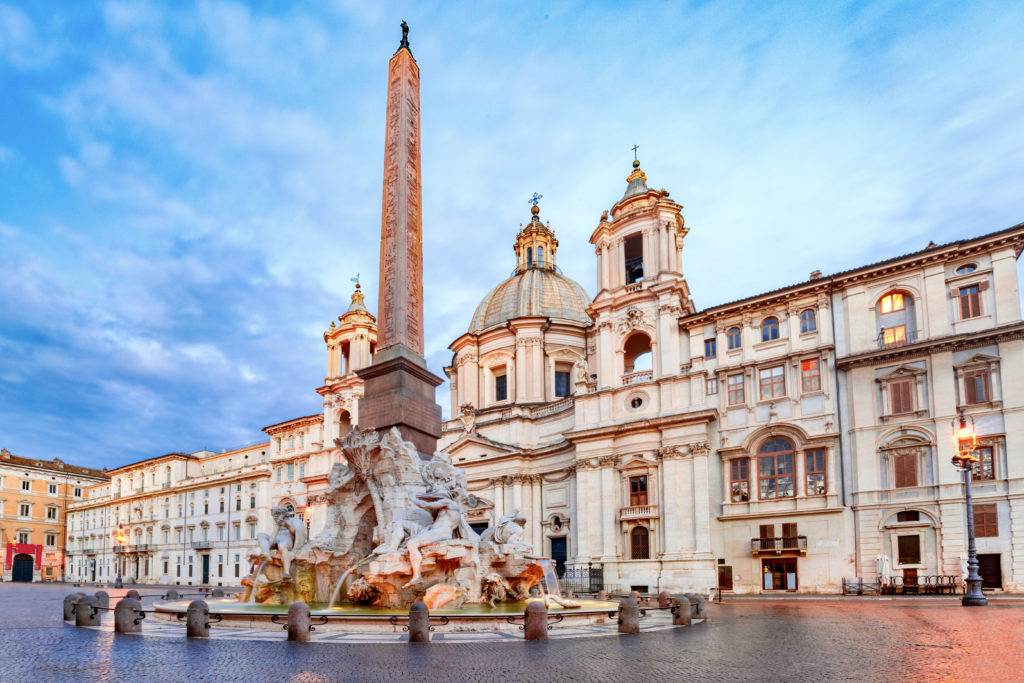
Rome can be akin to experiencing magic. But to properly walk through antiquity, it helps to unlock the background of Rome’s tumultuous 28 century history.
Rome is one the most powerful empires to ever exist. There are endless tales of conspiracies, imperial shenanigans, murder plots, back stabbing, artistic rivalries, wretches excesses, and other riveting drama.
These quirky, and sometimes astounding, facts and stories about Rome make its ancient history come to life.
If you’re a travel nerd like me, you’ll want this fun and fascinating trivia list of historic facts (and myths!) about Rome to read before your visit.
I hope you enjoy reading these fun Rome facts, whether you’re planning your own trip or just dreaming for now.
Fascinating Facts About Rome
Here are 50+ must know facts about Rome. You can test your knowledge and see which Rome facts you already know and which Rome facts may surprise you.
1. Rome’s Has A Murderous Origin Story
Rome’s origin story is full of intrigue, drama, and murder. Legend holds that Rome was founded by the the mythological twins Romulus and Remus.
The boys were allegedly descended from Venus and Mars. They were abandoned by their parents, placed in a basket floating down the Tiber River.
But they were rescued and suckled by a she-wolf named Lupa. She then turned them over to a shepherd to raise.
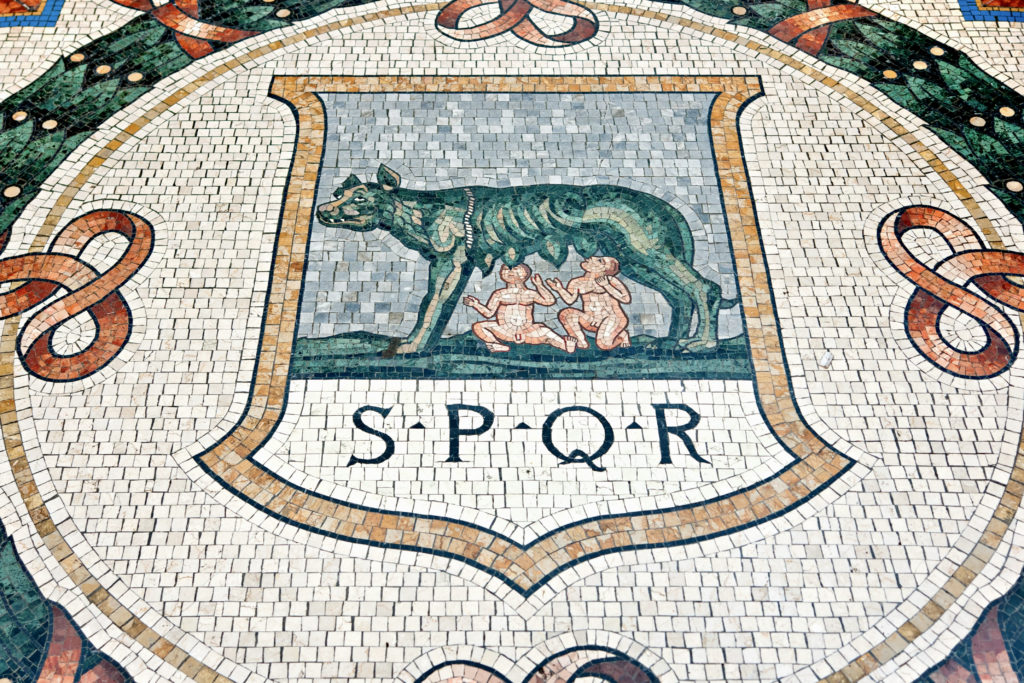
The twins made their way to a future Rome. Once there, a sibling spat ensued. The brothers wanted to found the city on different hills. Romulus liked Palatine Hill, while Remus preferred Aventine Hill.
They waited for an augury, or sign from the gods. It favored Romulus, who got to work building. Annoyed with his disfavor, Remus mocked his brother.
Lacking any tolerance and full of ambition, Romulus put Remus to death. Romulus then named his city “Roma,” after himself.
Despite the fratricide, Romulus was acclaimed and revered by Romans. For millennia, the myth of the twins was celebrated during Lupercalia.
READ: The Rise and Fall of the Ancient Rome
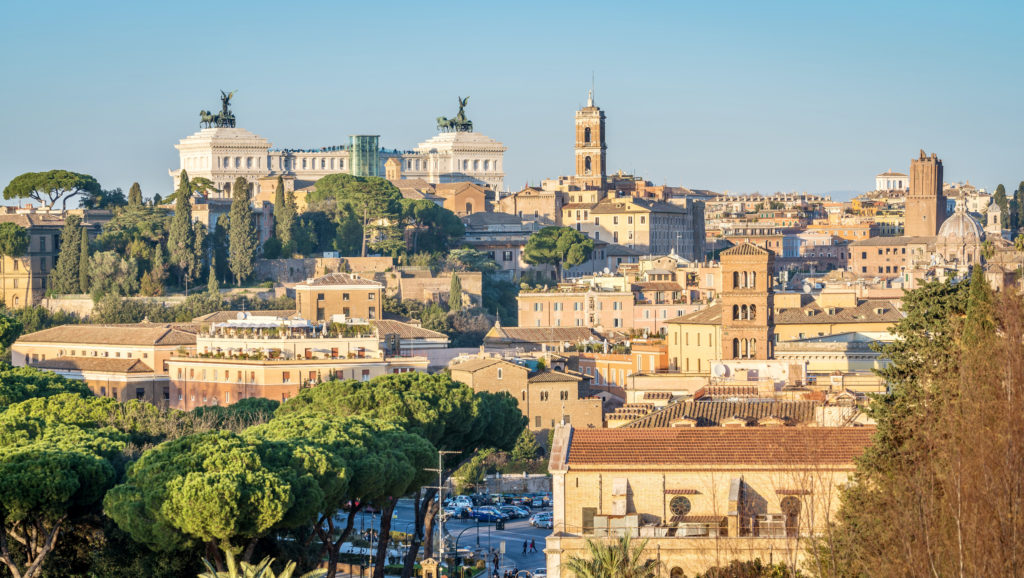
2. Rome Was Built on Seven Hills
According to legend, Rome was built on seven hills. Romulus founded the city on the Palatine Hill in 753 B.C.
But Rome wasn’t known as Rome then. It was more of a confederation of villages. The seven hills were occupied by independent small settlements of Sabines and Etruscans.
It made sense to build on high ground for purposes of defense. And, because Rome was a swamp, there was no choice but to go up some distance.
When the swampy valleys between hills were drained and replaced with public forums, the city of Rome came into being.
3. The Roman Forum Was the Center of Daily Life
The Roman Forum was the beating heart of ancient Rome. The forum is a rectangular valley running from Arch of Titus to the Capitoline Hill.
The forum was the seat of power and Rome’s central showpiece. Though now mostly lovely rubble, the forum was once a grandiose district.
It was the social, political, religious, and business center of Rome. It was home to white temples, grand basilicas, and vibrant public spaces.
This was where the Senate met, where the vestal virgins lived, and where orators gave speeches. The law courts and criminal courts were also there.
Here’s my complete guide to the monuments of the Roman Forum.
>>> Click here to book a ticket to the imperial ruins
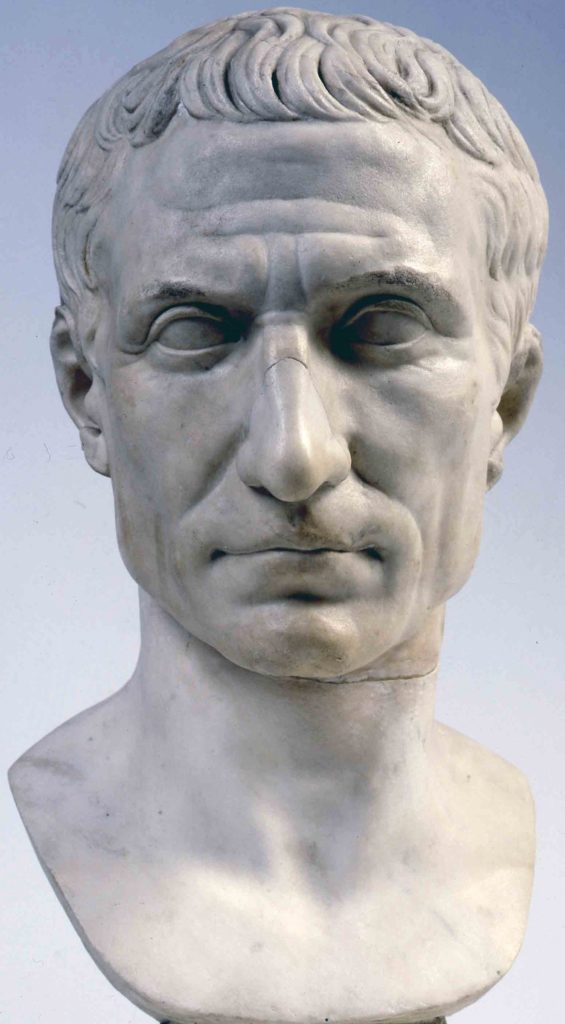
4. Julius Caesar Killed The Roman Republic
Caesar bridged the gap between the Roman Republic and the Roman Empire. In 44 B.C., Caesar declared himself “dictator for life.”
This didn’t sit well with his political opponents. Shortly thereafter, Caesar was assassinated by Brutus, in a conspiracy with senators. They feared Caesar would crown himself king.
Caesar’s death made him a martyr. It incited civil wars that led to the downfall of the republic.
Caesar’s heir, Octavian, came out on top of the struggle. He went head-to-head with Mark Anthony and Cleopatra and won, becoming the first emperor of Rome.
Octavian adopted the name Augustus. He’s generally considered Rome’s greatest emperor.
5. Emperor Augustus Was A Master Propagandist
Another interesting fact about Rome is that its first emperor, Augustus, had a thing for commissioning sculptures of himself. It’s estimated that 25,000 to 50,000 statues were produced.
The statues weren’t just decorative. They were powerful pieces of early Imperial propaganda. A wily Augustus wanted to distance himself from his predecessors’ excesses.
Augustus claimed to act for the glory of the Rome, not for personal power. Augustus appealed to Roman citizens by leading a frugal and modest life. He wanted to be seen as the great man who “saved” Rome and ushered in a new era of peace.
Augustus used the power of images to project these ideals. In his portraiture, he’s sometimes portrayed as military hero, but also as a wise and cultured man.
His visual iconography also conveyed a sense of immortal divinity. Images of Augustus sometimes look like an idealized Apollo. And, indeed, upon his death, the Senate declared Augustus to be a god.
READ: History of the Roman Emperors
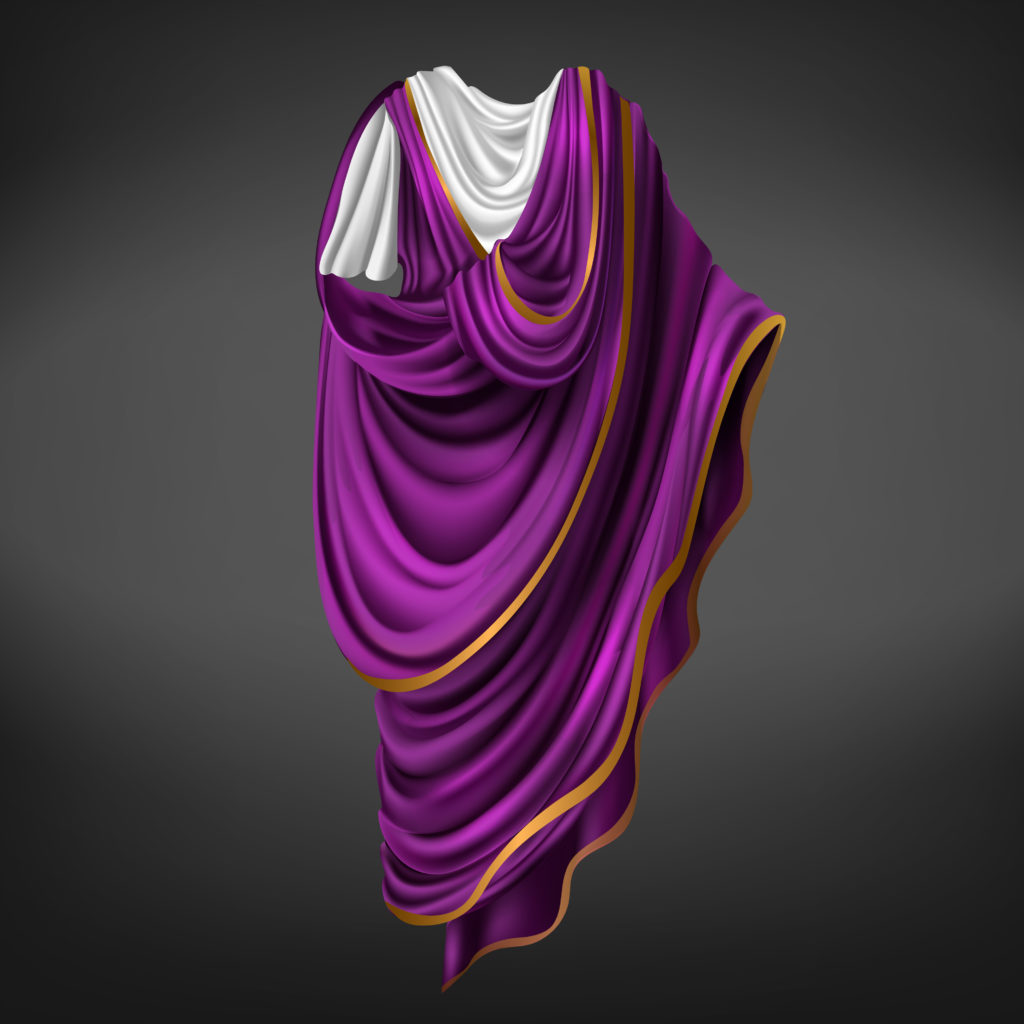
6. Only Emperors and Senators Could Wear Purple
In ancient Rome, purple was the color of royalty. It designated status and was a way to flaunt wealth.
And while purple is flashy, it was more important at the time that purple was expensive. It was worth more than gold.
Dyes were difficult to produce in the ancient world. Purple was pricey because purple dye came from snails.
After the Republic became the Empire, purple was increasingly associated with the emperor and his cohorts. According to Roman historians, Caligula once sentenced a Roman client-king to death for the arrogance of wearing purple.
To become emperor was to be “raised to the purple” and to be the child of an emperor was to be “born in the purple.”
7. Julius Caesar’s Grave Is In the Roman Forum
If you’re in Rome, you can actually visit the gravesite of Rome’s most famous citizen, Julius Caesar. On the ides of March, Caesar was stabbed to death at Pompey’s Theater in the Largo di Torre Argentina.
Mark Antony gave a rousing funeral oration in the Roman Forum, which rallied support for Caesar. You know the one — “Friends, Romans, countrymen, lend me your ears.”
Caesar was cremated a few days later near the spot where Antony aroused Roman passions. The spot became a cult site.
In 29 B.C., Augustus, Caesar’s adopted son and heir, came to power. He erected and inaugurated the Temple of Caesar in 29 B.C. on the location where Caesar was cremated.
>>> Click here to book a ticket and tour of the Roman Forum
The temple is just a meager ruin now. It can actually be hard to find without a guide. It’s nothing more than the base of the pedestal where orators once stood. Visitors leave flowers and coins daily.
To find it, stroll through the mammoth Arch of Constantine. Then, walk down the Via Sacra, the main road of the forum.
Behind the columns of the Temple of Vesta and the Temple of Castor and Pollus, you’ll see a small metal roof and a piece of stone wall. That’s where you’ll find all that remains of the Temple of Caesar.
You can also now visit the site of Caesar’s assassination, Largo di Torre Argentina (shown above). After a restoration funded by Bulgari, the Largo opened to the public in June 2023.
8. Romans Invented Concrete
How’d the Romans do it? How did they build all their incredible temples and monuments?
Well, an interesting fact about Rome is that Romans invented the use of poured concrete. The concrete was made with a recipe of limestone, sand, water, and volcanic ash from Mt. Vesuvius.
The builders would create a massive wooden form or model of a piece of the building. Then, they would pour in the concrete and let it dry.
This material allowed them to build on a large scale and use design elements like rounded arches. These secret ingredients helped Roman monuments survive 2,000 years of earthquakes and floods.
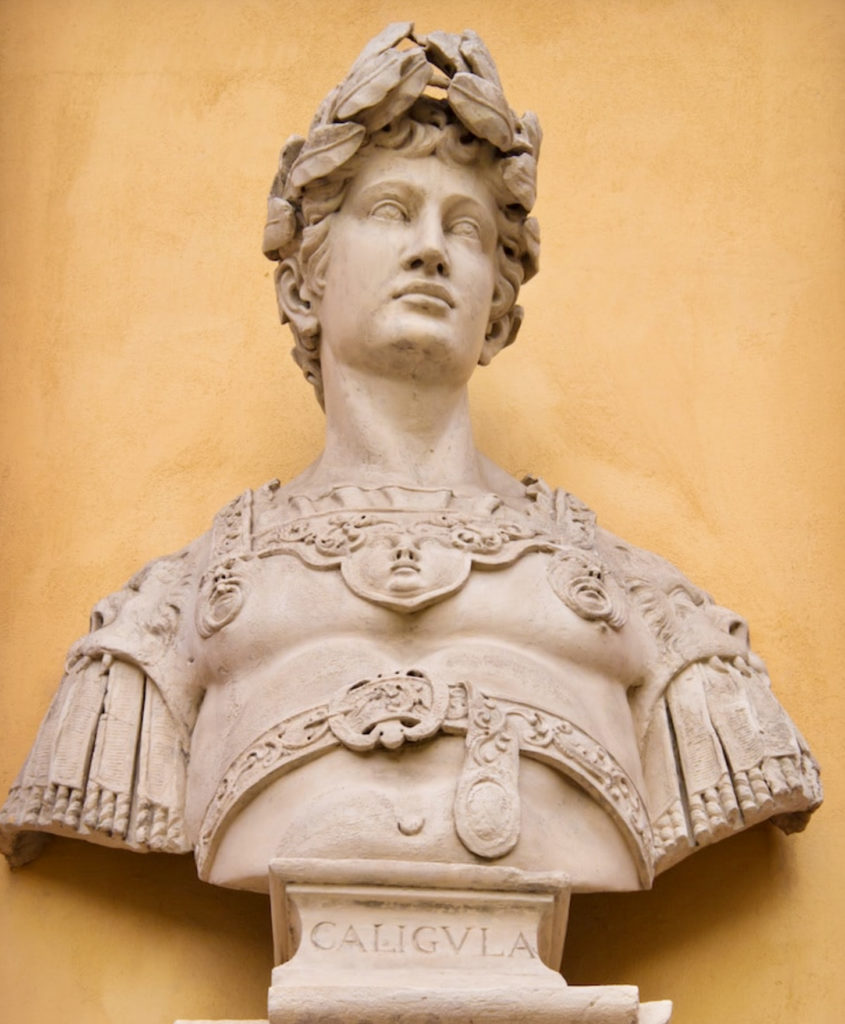
9. Caligula May Have Had A Psychiatric Disorder
Caligula was the third of the Caesarian emperors, succeeding Tiberius. Caligula is known as one the mad Roman emperors, thanks partly to the historian Suetonius.
Caligula was accused of incest with all three of his sisters. But what really got Caligula in hot water with his peers was his profligacy. He spent money like water and wallowed in luxury.
Caligula also ordered random executions, saying “he had the right to do anything to anybody.” He attempted to promote his horse to the position of consul.
Some historians theorize that Caligula’s insanity was neuropsychiatric, possibly due to lead poisoning or epilepsy.
In 41 A.D., the Praetorian Guard assassinated Caligula at age 28 in the Neronian Cryptoporticus. Like Caesar, he was stabbed many times by a group of conspirators. Caligula learned by actual experience that he was not a god.
10. Nero’s Golden House Was Intentionally Destroyed
The Emperor Nero is another reviled Roman emperor. He build the most opulent and expensive palace in Rome’s history. And he died for it.
Nero is viewed as one of history’s great criminals. According to ancient texts, Nero killed his mother and two wives. Legend holds that he set the great fire of Rome so that he could rebuild the city to his liking.
Post fire, Nero built the Golden House, Domus Aurea. His massive pleasure palace was a gaudy over-the-top affair with marble, gold, and frescos.
Eventually, Nero’s debauched lifestyle caught up with him.
For his misdeeds, Nero was declared a public enemy. He committed suicide at age 30. For a decade after his death, Nero’s emblematic palace was looted, destroyed, and filled in with brick.
The palace was consigned to oblivion. But the destruction of the Golden House wasn’t quite as extensive as the emperors intended. In fact, much of the Golden House remained intact underground.
At the end of the 15th century, Domus Aurea was discovered by accident when a young man fell into a crevice.
To his surprise, he found himself surrounded by vivid paintings. Renaissance artists like Michelangelo came to admire the frescos.
>>> Click here to book a tour of Domus Aurea
11. Nero Might Not Have Been A True Villain
Another fact about Rome you may not know is that Nero may just have been a bad boy, not one of history’s greatest villains. Nero is routinely portrayed as the most decadent and sexually deviant of all Roman emperors.
But it’s unclear if this was really true or a caricature. Imperial Rome was a violent and decadent place, after all.
It was common practice to vilify a deposed emperor. The worst stories may be sheer gossip.
Moreover, as we all know, history is written by the victors — politicans who were motivated to smear Nero or hostile historians who didn’t much fancy the emperors.
At a minimum, Nero was an egotist and a reckless Trumpian-type wannabe rock star. He busied himself with theater and failed to play the necessary political games to keep his crown.
12. Commodus Believed He Was Hercules
Most of us know Emperor Commodus as the deranged son of Marcus Aurelius from the movie Gladiator. The protrayal isn’t far off.
Commodus fancied himself a reincarnation of Hercules. He used to drape himself in animal skins for dramatic effect. In the sculpture above he has all the signs of Hercules — the club, the lion’s skin, and the golden apples of Hesperides.
This was one of many statues erected all over the city. One statue was solid gold and weighed nearly a ton.
But divinity wasn’t enough for Commodus. He descended into paranoia and began killing everyone around him. Brute power was the order of the day in Ancient Rome. But Commodus was malignant.
Often, he’d beat people to death with his club. When that wasn’t enough, he’d head off to the Colosseum to compete as a gladiator.
Commodus was eventually murdered. Like Nero, his memory was damned.
13. Hadrian Popularized Beards
Ancient Rome was nothing if not fashionable. And Hadrian set some standards.
Hadrian was known as one of Rome’s “five good emperors.” He was the total package — expert administrator, shrewd politician, and pragmatic military strategist.
Hadrian was enamored with architecture, a prolific public builder, and adored all things Greek. He was nicknamed “the little Greek.” He even insisted that some of his servants speak Greek.
Despite the fact that Rome had been clean-shaven for centuries, Hadrian was the first emperor to wear a beard. This was a Greek custom that he adopted.
The emperor’s beard was imitated throughout the Roman Empire, by men both young and old. The bearded coiffeur is omnipresent on statues from that era.
>>> Click here to book a ticket to Hadrian’s Villa
READ: Guide To Hadrian’s Villa in Tivoli
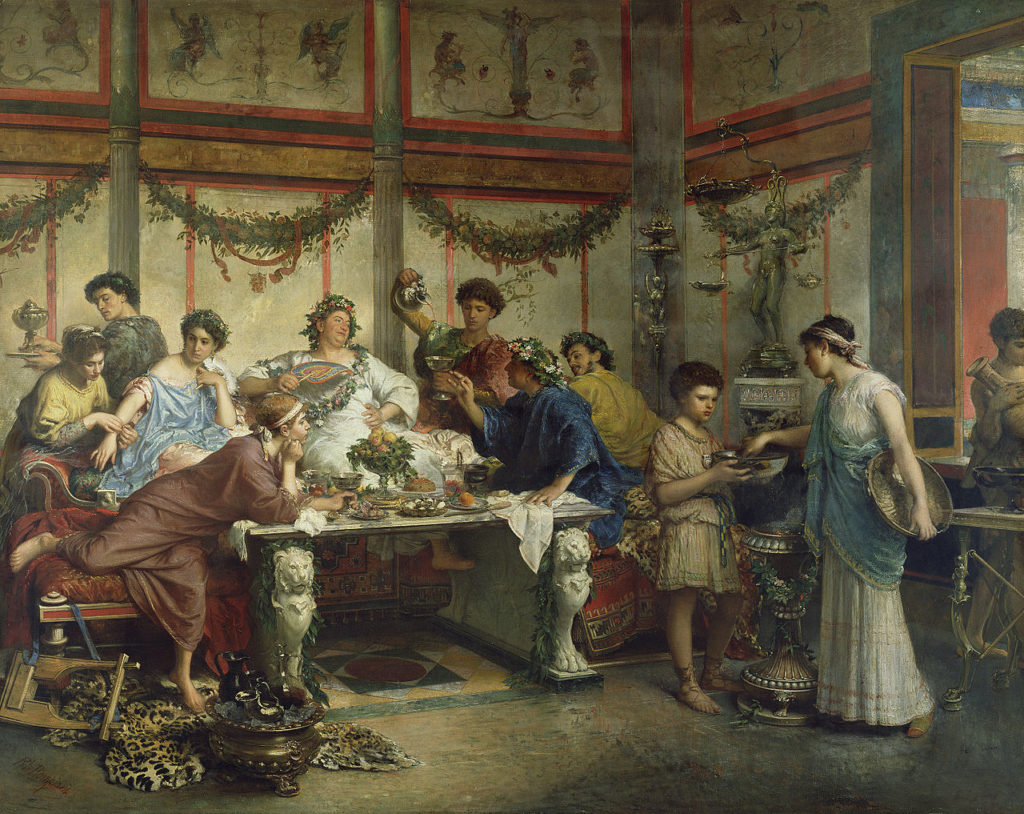
14. Rome Went Wild During Saturnalia
Saturnalia is an ancient Roman pagan festival honoring the agricultural god Saturn. Saturnalia was held in mid December. Saturnalia celebrations are the source of many of our Christmas traditions.
People decorated their homes with wreaths and other greenery. They shed their traditional togas in favor of colorful clothes.
Saturnalia was a topsy-turvy bacchanalia. Ancient Romans would feast, drink, sing in the street naked, gamble, and make noise.
The ordinarily rigid and conservative social restrictions of the Romans changed. Slaves didn’t have to work during Saturnalia. They were allowed to participate in the festivities.
In some cases, they sat at the head of the table while their masters served them.
15. The Colosseum is the World’s Largest Amphitheater
The 600 foot high Flavian Amphitheatre is nicknamed the Colosseum. It was inaugurated in 80 A.D. with a grand 10 day festival. Despite the ravages of time, it’s the largest standing amphitheater in the world.
Today, the Colosseum is the most instantly recognizable monument from the classical world. The Colosseum is an incredibly well-preserved piece of brilliant engineering.
The Colosseum was built under the reign of three emperors, all whom came from the Flavian family. It covers approximately 6 acres. It had over 80 entrances.
In its glory days, the Colosseum was a vivid white with painted trim and frescoed hallways. There were monumental statues of the Greek and Roman gods in the arches of the middle two stories. The top story had a retractable canvas dome to shade spectators.
The Colosseum got its nickname from the Colossus of Nero that once stood outside it.
16. You Can Now Go Underground in the Colosseum
Did you know that you can now visit the secret underground of the Colosseum? If you book a guided tour, you can see “hypogeum” or the Colosseum underground.
The Colosseum’s underground basement was the staging area for events. It was an elaborate network of subterranean dressing rooms, tunnels, animal cages, and holding rooms beneath the arena floor.
Slaves, prisoners, animals, and gladiators were kept there before their “performances.”
On a tour, you can inspect animal cages, gladiator corridors, back stairs used by the slaves, trap doors, and the launching point for mock naval battles.
Here’s my complete guide to the underground Colosseum.
>>> Click here to book a tour of the underground Colosseum
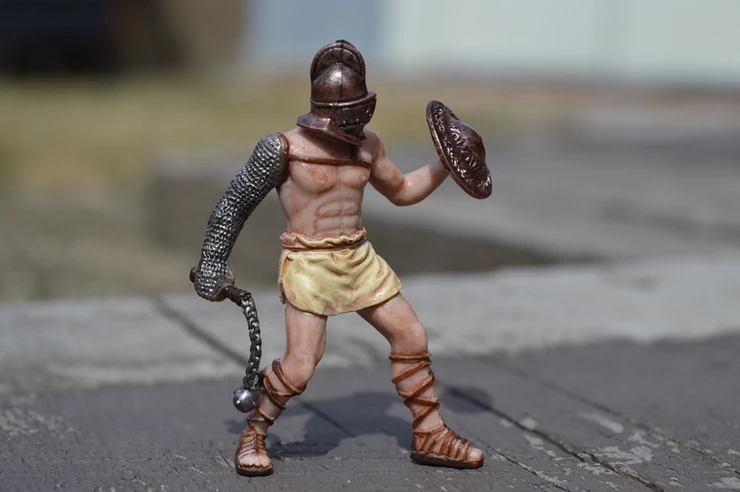
17. Gladiator Fights Were Blockbuster Entertainment
Romans were rabid about entertainment. The Colosseum was deliberately built to mollify the masses. Admission was free. This was where the Romans had fun.
The Colosseum hosted jaw dropping spectacles and bloody contests. The games are believed to have started in the 3rd century B.C. At their peak, there were 162 games in Rome, occurring on public holidays, religious holidays, and imperial holidays.
The games were a form of ancient theater re-creating far flung lands and mythological themes for the masses. There were many variations.
The spectacles pitted men against men, men against beasts, and beasts against beasts. Sometimes the Colosseum was flooded for naval battles.
The games were blockbuster entertainment. They were expertly stage managed, slowly and inexorably building to a grand crescendo. The gladiators themselves were modern day sports celebrities, hero worshipped by the masses.
It’s believed that 500,000 men and 1 million animals died inside the Colosseum.
18. Rome Has the Most Christian Churches In The World
It’s a fact that Rome is a city of churches. It’s believed that Rome has over 900 of them.
Rome is home to some of the world’s most beautiful churches from the Romanesque, Gothic, Renaissance, and Baroque periods. Rome’s churches are especially rich in Baroque era decoration.
If you open their ornate doors, you’ll find some of the best art in Italy.
Here’s my guide to Rome’s most beautiful churches.

19. The Borromini-Bernini Rivalry
The Roman architect Borromini and the sculptor-architect Gian Lorenzo Bernini were two of the greatest artists of the Baroque working in Rome. But they had some petty disagreements. The pair of sworn enemies bickered like children.
They worked together, though not happily, on the Palazzo Barberini and St. Peter’s Basilica. Bernini thought big. But Borromini worked with a jeweler’s precision.
One legendary example of their animus is the feud of the Piazza di Spagna. Borromini worked on a palace (a commission he stole from Bernini) opposite Bernini’s house.
In the great chisel-off, Borromoni sculpted donkey ears pointing at Borromini. In response, Bernini sculpted a penis pointing at Borromini’s building. Both sculptures were later removed for indecency.
Another more apocryphal example is in the Piazza Navona. Bernini’s Four Rivers Fountain faces the Borromini-designed Sant’Agnese Church. Bernini lost the commission for the church to Borromini.
According to legend, two of the figures in Bernini’s fountain shield their eyes from the awful sight of the church.
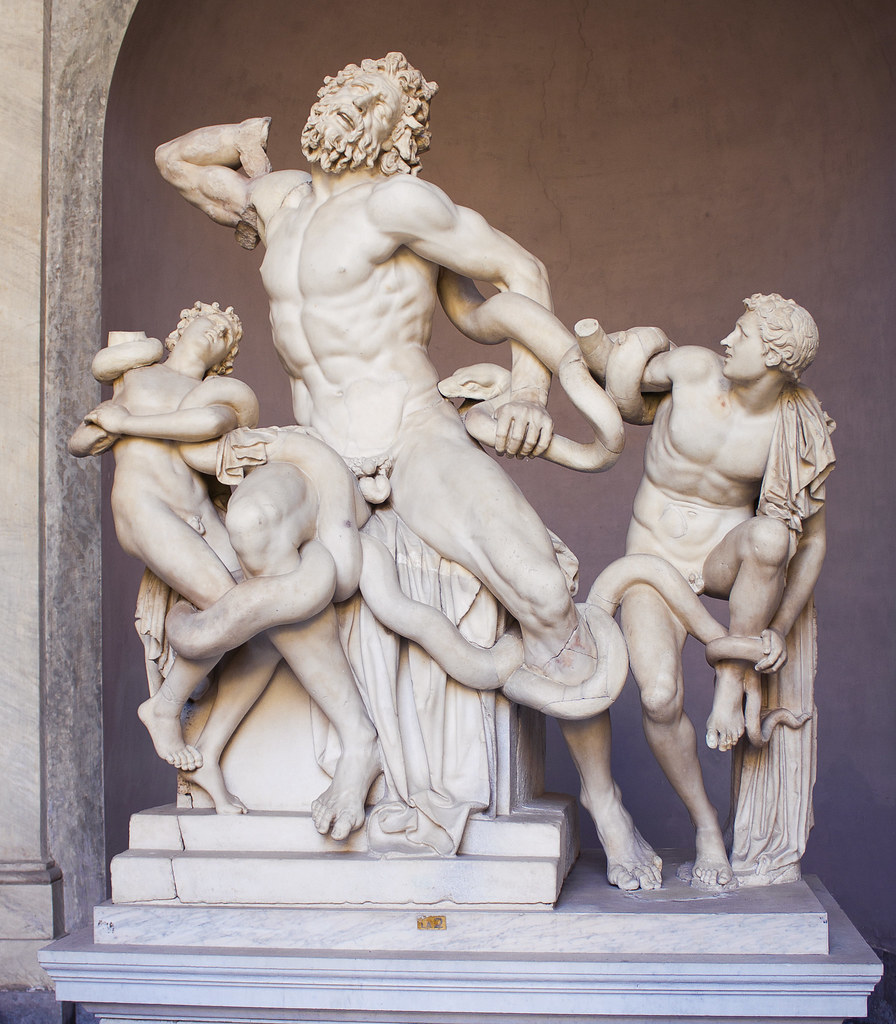
20. The Discovery of Laocoon Helped Jump Start the High Renaissance
Laocoön is one of the world’s most ancient and valuable sculptures. It’s a marble masterpiece from Greece’s Hellenistic period. It likely dates back as far as 323 B.C. It’s housed in the Vatican Museums.
>>> Click here to book a Vatican ticket
Laocoön is based on an ancient Greek myth. It depicts a deadly attack. The priest Laocoön and his sons are assaulted by a writhing sea serpent sent by either Poseidon or Athena.
It’s a tormented, action packed vignette. To no avail, three figures desperately try to untangle themselves from the serpent.
The sculpture was famously unearthed in the Esquiline Vineyard in 1506. Happily, Michelangelo recognized its significance and pressed for its restoration.
The classical sculpture deeply influenced Michelangelo and other Renaissance artists. The naturalistic style became a hallmark of Renaissance art.
21. Trevi Fountain Competition
The design of the Trevi Fountain was chosen thanks to a competition. Italians loved a good competition, a tradition that began in the Renaissance.
In 1732, Pope Clement XII invited local artists to design an expansion for the existing (not so attractive) fountain at the end of the Acqua Vergine.
The architect Nicola Salvi ultimately won the competition. But it was rumored that Galileo was the first pick. However, Galileo was from Florence, not Rome. Not a local, he was removed.
Today, it’s customary for tourists to throw coins into the fountain to ensure their return to Rome. On average, 3000 euros are collected each day and donated to charity.
22. The Famous Roman Painter Caravaggio Was Accused Of Murder And Banished
Caravaggio is the most famous painter of the Baroque period. He painted like an angel, but acted like the devil.
With jet black hair and glaring eyes, he led a scandalous life of violence, intrigue, and volatility. He fought, whored, drank, gambled, and dueled his life away. Along the way, he created some of the world’s most beautiful and visceral art.
Caravaggio was an irascible, hot tempered man with a big ego. He dressed in black and carried daggers, pistols, and swords.
Caravaggio was quick to injure people, with either his weapons or his tongue. He got into one street brawl after another.
In 1606, he murdered a possible rival pimp and gang leader, Ranuccio Tomassoni. Pope Paul IV exiled Caravaggio from Rome for life.
He also put a bounty on Caravaggio’s head, granting anyone permission to kill him. At the height of his career, Caravaggio was forced to live the rest of his life as a fugitive.
>>> Click here to book a tour of Caravaggio highlights in Rome
23. The Borghese Gallery Was Founded By a Thief
After the Vatican Museums, the Borghese Gallery is one of the best museums in Rome. But it has a lurid backstory. It was founded by a renegade cardinal thief.
The villa was commissioned in 1613 by Cardinal Scipione Borghese to house his impressive collection of Roman, Renaissance, and Baroque art. The cardinal was a fan of Bernini and helped him rise to fame.
But Borghese was more than just an ardent and obsessed collector. He acquired art work by unscrupulous means. In his obsessive quest to build a preeminent collection, he used any tactic, however illegal, to acquire a masterpiece he coveted.
Scipione would confiscate art from people who hadn’t paid taxes. He’d jail artists on trumped up charges who refused to sell their paintings to him. The big bully would forcibly remove pieces from artists’ studios.
Scipione once stole Raphael’s famous Deposition from a convent altar in the dead of night. When there was a protest, he returned a copy of the painting.
READ: Guide To Raphael’s Most Famous Paintings
Though his methods were dastardly, Scipione’s taste was unassailable. Scipione was expert at sniffing out talent. The Borghese Gallery boasts some of the finest works of Italian art.
>>> Click here to book a timed entry Borghese ticket
24. The Pantheon Still Has The World’s Largest Unsupported Dome
Without a doubt, the Pantheon is the most famous and best preserved monument from ancient Rome. It’s the only piece of Imperial architecture left intact.
The Pantheon is a breathtaking work of ancient Roman engineering. The church’s most emblematic feature is its perfect unsupported spherical dome.
The vault is meant to symbolize the vault of heaven. It’s the largest unreinforced masonry dome every built.
The oculus at the top is 30 feet wide. It functions as what is known as a compassion ring in architectural terms, halting the pull of gravity outward.
The technology behind the Pantheon dome was lost for centuries after it was built. Domes like this weren’t built again until the early Renaissance.
The famed dome became one of the most imitated pieces of architecture in history. It became the model for Michelangelo’s dome for St. Peter’s Basilica and for Brunelleschi’s dome for Florence Cathedral.
The dome is actually larger than St. Peter’s dome. But you wouldn’t know it because of its flattened exterior appearance.
>>> Click here to book a tour of the Pantheon
25. The Pantheon’s Inscription is Inaccurate
The lower part of the pediment proclaims, in Latin “M.AGRIPPA.L.F.COS.TERTIUM.FECIT.” Translated, this means “Marcus Agrippa, three times consul made this.”
In fact, the Pantheon was built by Emperor Hadrian long after Agrippa’s death. But Agrippa had built a monument there before. Agrippa’s original version was destroyed by fire in 80 AD.
This engraved pediment was likely a remnant left over from Agrippa’s original building. And Hadrian decided to carry over the dedication, either as a sign of humility or to reinforce the the cult of Augustus.
26. St. Peter’s Basilica is the World’s Largest Church
Another fun fact about Rome is that St. Peter’s Basilica is the most famous church in Christendom. It’s also the largest at almost two football fields long. Designed by Bramante, Raphael, and Michelangelo, it’s a true Renaissance masterpiece.
The basilica may be the most ornate space you’ve ever stepped foot inside. It’s filled with an intense visual array of precious treasures and grandiose decoration.
St. Peter’s Basilica was completed after 120+ years of construction, the reign of 18 different popes, incalculable cost, and the direction of 12 different architects.
The dome of St. Peters, with input from the revered Michelangelo, is the tallest in the entire world. The basilica is the burial place of Saint Peter and past popes.
This is where you’ll find the famous Bernini Baldachin canopy and Michelangelo’s tragically beautiful Pieta. Legend holds that the Baldachin was made from bronze looted from the Pantheon.
>>> Click here to book a tour of St. Peter’s Basilica with a dome climb
27. Piazza Navona Was Once A Racetrack
Piazza Navona is sometimes called the Square of Fountains. Piazza Navona is the very symbol of Rome. This famous square is a long rectangle.
The square dates back to the time of Emperor Domitian. He used it as a racetrack for chariot races and sporting matches. The buildings surrounded the piazza were once stadiums with screaming fans.
Piazza Navona was even turned into a lake in the summers. The drains of the fountains were closed and the square became flooded with water.
Aristocrat would decorate their coaches like traditional gondolas. Sometimes there were mock naval battles.
Today’s buildings date from the 16th century. The Doria Pamphilj family commissioned the Church of Sant’Agnese and the Bernini fountain and restored the other fountains
28. Vittorio Emmanuel II Monument
Romans either love or hate the Vittoria Emmanuel II Monument on Capitoline Hill. It’s a supersized gleaming white monument built to honor Italy’s first king. The 43 foot long statue of Vittorio in front is one of the world’s largest equestrian monuments.
You really can’t miss the monument. It’s right in Piazza Venezia. The monument is nicknamed the “wedding cake” or “typewriter” monument. Or simply called the Vittoriano.
You can go up the steps and admire it for free. Inside, there are cafes and a museum, with views from the cafe terrace and other spots.
But what most people fail to do is go around back. There’s an elevator that takes you up to the tip top for some of the best views in Rome.
The elevator is expensive at 10 euros. But I thought it was completely worthwhile. You have stunning views of the Rome Forum, Piazza del Popolo, and the dome of St. Peter’s.
>>> Click here to book an elevator ticket
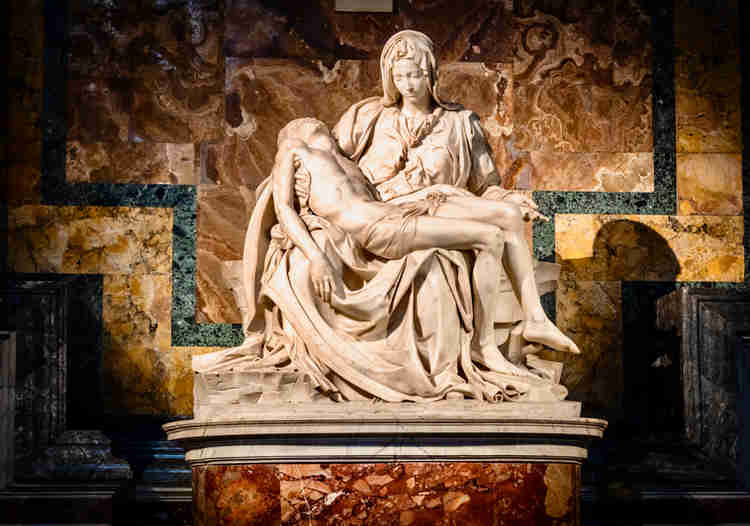
29. Michelangelo’s Pieta Was Attacked
Michelangelo’s Pieta is the most famous and popular thing to see inside St. Peter’s Basilica. The Pieta itself is tragically beautiful, a moving sculpture in which stone seems soft.
In 1972, the Pieta was attacked by a mentally deranged geologist. It suffered 15 hammer blows. Her left arm was knocked off, her eyelid chipped, and she lost a significant part of her nose.
Most fragments were recovered, but the nose was not. A selfish pilgrim made off with it. A new nose was created. Over 10 months, the sculpture was restored, using white marble dust and invisible glue.
After that fiasco, the Pieta was placed in lockdown behind bulletproof glass. You can’t see the statue up close anymore.
30. Rome Was Obelisk Crazy
Another interesting fact about Rome is that there are more obelisks in the city than in the country of Egypt. There are 13 in Rome.
An obelisk is a tall four sided tapering monument that ends at the top with a pyramid. The obelisks in Rome were either gifts to the Roman emperors or confiscated by conquest.
The largest obelisk is in the Piazza di San Giovanni in Laterano, in front of one of Rome’s most beautiful churches. The most beautiful obelisk is the one near the Pantheon in Piazza della Minerva. It’s atop an elephant sculpture by Bernini.
31. Trajan’s Market Was The World’s First Shopping Mall
Trajan’s Market is a large complex of ruins that was part of Trajan’s Forum. This forum was the largest and most advanced of six imperial forums in Rome, as befitting Rome’s most popular and powerful emperor dubbed the “best leader.”
Trajan’s Market was built in the 2nd century A.D. by Trajan’s favorite architect, Apollodorus of Damascus. It’s affectionately called the world’s “first shopping mall.”
Trajan’s Market was a dense complex. It was once 6 stories with 150 shops and offices, set into the side of Quirinal Hill.
The structure is remarkable. It shows that Romans didn’t just build with columns and pediments. Powered by concrete, this urban structure was light filled, with windows and atriums.
32. There Were Once Underpants In The Sistine Chapel
On my last trip to Rome, I learned that Michelangelo’s Sistine Chapel fresco, The Last Judgment, got a makeover after his death. It was censored.
Underpants were added to the nudity-filled fresco. How did this come to pass?
For Michelangelo, the perfection of the nude human form was the purest expression of the divine. But some of his contemporaries thought the nudity was just too much to bear. They were scandalized and repulsed by the fresco’s naked bodies.
History was moving away from the High Renaissance into the oppressive Counter Reformation. In 1565, the Council of Trent formally condemned the portrayal of nudity in religious art.
With Michelangelo barely in the grave, Pope Pius IV hired Daniele da Volterra, a student of Michelangelo’s, to “fix” the fresco.
Paintbrush in hand, Volterra covered the offending genital bits with loincloths, veils, and draperies — effectively putting underpants on many figures.
The Last Judgment was restored in 1980-94. Most of the “underpants” couldn’t be eradicated. Volterra had scraped away and destroyed much of Michelangelo’s original painting.
But restorers did manage to remove 17 of the 40 breeches. In the battle between artistic license and the forces of restraint, the end result was a compromise.
33. Michelangelo-Raphael Rivalry
Another interesting fact about Rome is that its artists were very competitive. In particular, Michelangelo didn’t play well with his fellow artists and competitors. He created his work in isolation and didn’t share any trade secrets.
One of Michelangleo’s principle rivalries was with another of Rome’s famed High Renaissance artists, Raphael. They were pitted against each other in the Vatican beginning in 1508.
While Michelangelo slaved away on the ceiling of the Sistine Chapel, Raphael was painting the new apartments of Pope Julius II.
These apartments are now known as the Raphael Rooms and are a highlight of a Vatican Museums visit. Raphael garnered rave reviews, angering Michelangelo.
Michelangelo wouldn’t let anyone see him work. So, conspiring with the architect Bramante, Raphael scheduled a secret nighttime visit to the Sistine Chapel to inspect his frescos.
Michelangelo found out about the clandestine visit and later claimed that Raphael had copied his work. The sourpuss said that “everything he knew he learned from me.”
To get back at Michelangelo for these barbs, Raphael included a likeness of Michelangelo in his famous painting, School of Athens. Raphael portrays him as Heraclitus, the weeping philosopher.
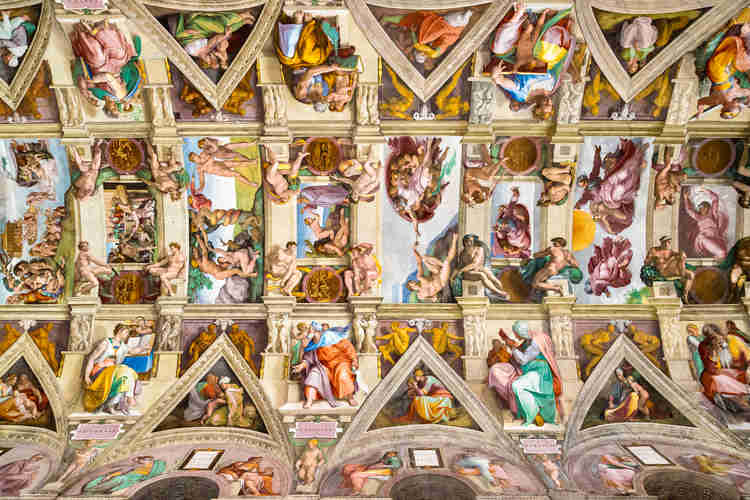
34. Michelangelo Didn’t Want To Paint The Sistine Chapel
One fact about Rome you might not know is that Michelangelo had no interest in painting his most famous masterpiece, the Sistine Chapel. In 1508, Pope Julius II summoned Michelangelo from Florence to paint the ceiling of his private chapel.
Michelangelo wasn’t enthusiastic about the project. He was first and foremost a sculptor.
Michelangelo had relatively little experience when it came to organizing a painting project on this scale. And he was already working on sculpting Julius II’s tomb, a project he preferred.
But Michelangelo had no choice in the matter. According to Julius II, it was “paint or hang.” In any event, Michelangelo was insanely talented and up to the task at hand — which the canny pope no doubt discerned.
Michelangelo signed the contract with Pope Julius II in 1508. He was 28 years old and had already carved his renowned David and Pieta. He demanded complete creative control.
35. Raphael May Have Died Of Too Much Sex
The painter Raphael was a notorious ladies’ man of the Renaissance. While Raphael was painting frescos in the Villa Farnesina, he began having a torrid affair with the baker’s daughter who lived down the street.
She was later immortalized in his famous painting (above), on display at the Palazzo Barberini.
Raphael’s infatuation consumed him. He began to skip work to see Fornarina. The villa’s owner, Agostino Chigi, understandably grew frustrated. He even had Fornarina kidnapped to prevent Raphael from seeing her.
But a lovestruck Raphael simply grew depressed. This all stalled Chigi’s grand project. Finally, Chigi gave up and had Fornarina move in to keep Raphael content.
In 1520, Raphael died abruptly at just 37. The diagnosis back then? Art historian Giorgio Vasari claims it was “too much sex,” which caused Raphael to spike a fever.
His bedmate on his last happy night? Most likely, La Fornarina.
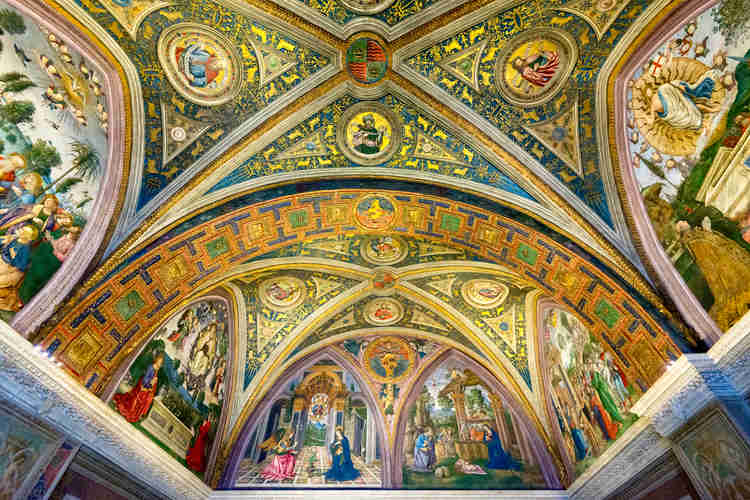
36. The Borgia Apartments Were Hidden For Centuries
The Borgia Apartments are a lavishly decorated suite of six rooms in the Vatican Museums. They boast some smashing Renaissance art.
The Borgias were a powerful and wealthy Spanish dynasty. One member of the family, Rodrigo Borgia, became Pope Alexandre VI.
He was a licentious pope, fathering 10 children and “living in sin” with one of his paramours. Alexandre had procured his election as pope through illicit means — corruption, intrigue, and outright bribery.
In the late 15th century, he commissioned the Italian painter Bernardino Pinturicchio to decorate his private rooms. Pinturrichio was known for his delicate and refined frescos.
When Pope Alexandre VI died, his rival and successor, Pope Julius II, refused to live in the rooms as a political statement. The Borgia Apartments were abandoned and sealed off, due to their scandalous association. They remained hidden away from the public for 300 years.
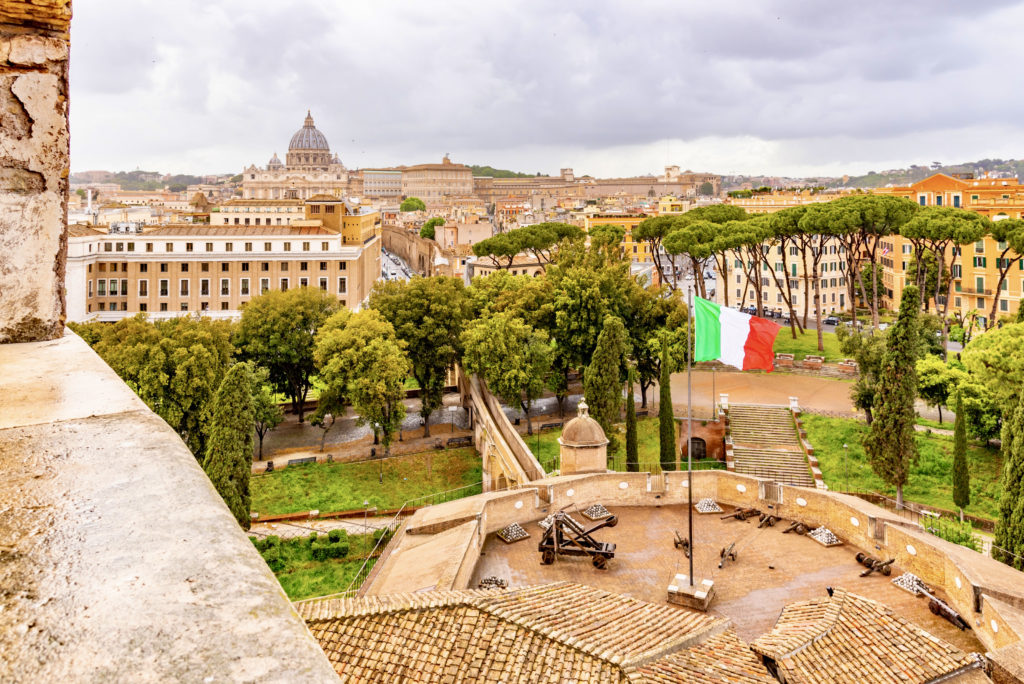
37. There’s A Secret Passage Between The Vatican And Castle Sant’Angelo
There’s a secret passageway to escape the Vatican in times of threat. The Passetto del Borgo is a secret corridor that leads from Vatican City to the nearby Castle Sant’Angelo.
In fact, the Passetto di Borgo served as a secret escape route for popes in at least two instances. In 1494, Pope Alexander VI used it to flee during Charles VIII’s invasion.
During the siege of Rome in 1527, Pope Clement VII used it to escape when Charles V killed the Swiss Guard. The pope didn’t leave the fortress-castle for six months.
The Passetto di Borgo even made an appearance in Dan Brown’s bestselling novel Angels & Demons. You can only see the Passetto on a guided tour.
38. Villa Farnesina Has Racy Frescos
Between 1506-11, the wealthy banker Agostino Chigi from Siena built Villa Farnesina, then titled Villa Chigi. Chigi was the richest man in Rome.
He was nicknamed “Il Magnifico” because of his luxurious lifestyle and flamboyant personality. With unlimited resources and good taste, he aimed to create a sumptuous Renaissance jewel and temple to true love.
Chigi’s Villa Farnesina wasn’t intended for casual teas. This was a show-offy party pad.
In the Loggia of Cupid and Psyche, cavorting gods and goddesses cover every inch of the walls. The theme is “love conquers all.”
There’s a marked presence of nude figures and a marked absence of religious iconography. This was a pagan setting for pagan frolicking. And you can visit to inspect the frescos yourself.
>>> Click here to book a tour of Villa Farnesina
39. The House of Augustus Has The Best Preserved Walls On The Planet
A good fact about Rome to know when visiting is that the House of Augustus is home to lavish red Pompeian frescoes. They’re the best preserved frescos from ancient Rome, superior even to those in Pompeii.
For nearly 2,000 years, the House of Augustus on Palatine Hill lay hidden. Archaeologists only discovered the ancient home in the 1960s. The House of Augustus was first unveiled to the public in 2014, to mark the 2,000 year anniversary of Augustus’ death.
Comprising two levels, the House of Augustus served as Augustus’ primary residence during his reign.
Most of the frescos are executed in the Second Pompeian Style, called the “Architectural Style.” It began in Pompeii, became the fashion, and was then adopted by Augustus.
>>> Click here to book a tour of the House of Augustus
40. There’s Loads of Free Art In Rome
Traveling in any city as large and popular as Rome can be very expensive. And many of Rome’s best museums have hefty entry fees, which can add up.
But one fact about Rome is that many of its must see sites and hidden gems are completely free, if you’re traveling on a budget. Rome is essentially a living museum with art sprinkled everywhere.
Most significantly, Rome’s churches open their ornate doors for free. Inside, you’ll find stellar art from the Renaissance and Baroque eras.
This free art in Rome includes works by such luminaries as Michelangelo, Raphael, Bernini, and Caravaggio. It also costs nothing to wander in Rome’s piazzas and parks, where you’ll find even more art on display.
Here’s my complete guide to free art in Rome.
41. You Can’t Sit On The Spanish Steps
As of 2019, you can no longer sit on the Spanish Steps. It’s classified as a national monument.
A new law cracked down on “bad behavior” in Rome. If you’re caught sitting on the Spanish Steps, you risk paying a € 400 fine.
And, by the way, the Spanish Steps aren’t Spanish. They’re just named after the Spanish Embassy at the top of them.
42. Rome Has A Lie Detector
The Mouth of Truth is most likely a Pavonazzo marble mask called La Bocca della Verita. It has the ambiguous face of an unknown pagan god with an open maw. It’s located in the portico of Santa Maria in Cosmedin Church.
Legend holds that, in medieval times, the carved mask was a device for determining whether a person was telling the truth. Suspicious people were brought to the sculpture. They took an oath and put their hand inside the gaping mouth while being interrogated.
If the detainee was being truthful, the mouth wouldn’t moved and you could keep your hand. If you were lying, the mouth would slam shut and bite off the hand.
The legend became famous via Hollywood. In the 1953 film Roman Holiday, the Mouth of Truth was used as a storytelling device. Now, there are lines of visitors willing to put their hand to the test.
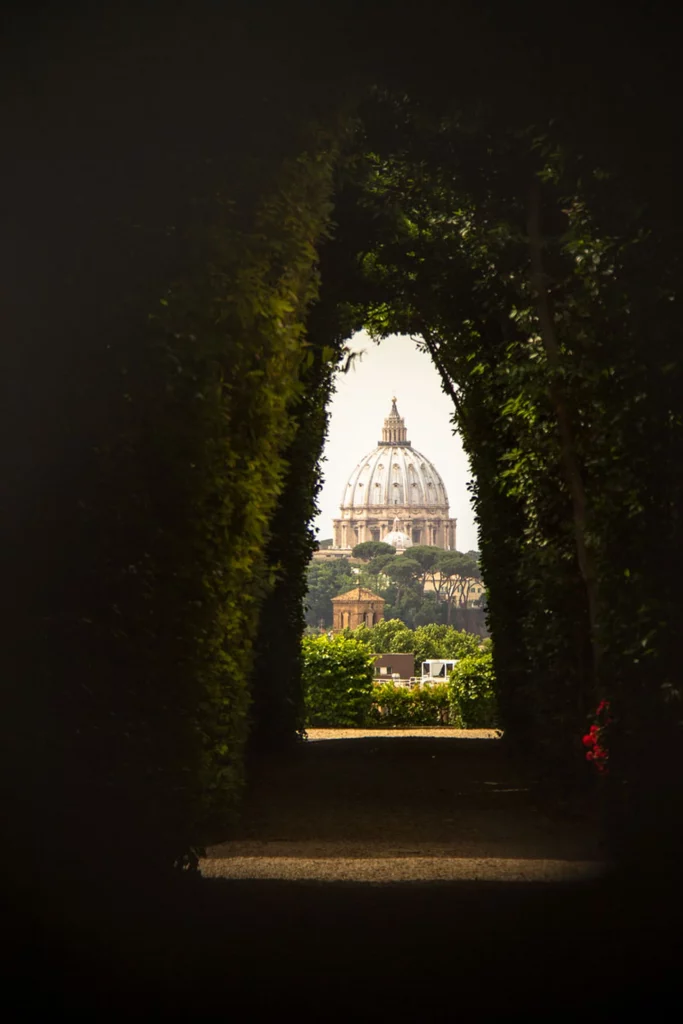
43. You Can See St. Peter’s Dome Through a Keyhole
The Aventine Keyhole is one of the most peculiar attractions in Rome. As the name suggests, it’s a keyhole through which you can peek.
As you put your eye to it, you will see an unobstructed view of St Peter’s Dome. The church is perfectly framed by the round edges of the keyhole itself.
The keyhole is in the door of the institute of the Knights of Malta. The official address is Piazza dei Cavalieri di Malta 3.
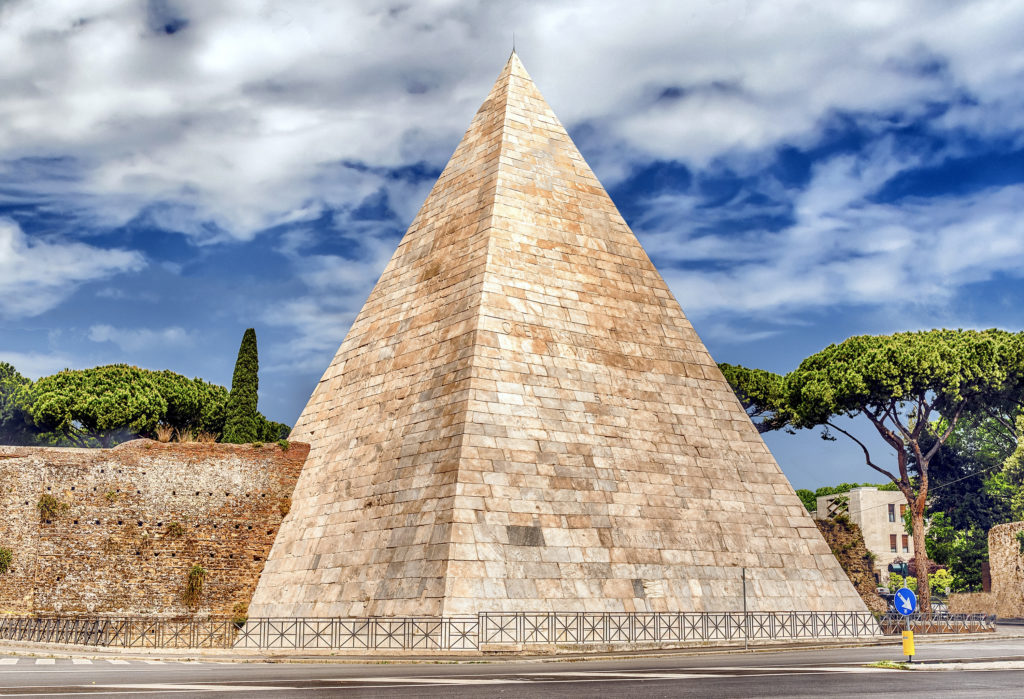
44. Rome Has a Pyramid
In the wake of the conquest of Egypt in 30 B.C., Egyptomania gripped Rome.
Two pyramids were known to have been built, and one remains. This era is when the obelisks started to appear as well.
The Pyramid of Cestius was most likely built between 18 and 12 B.C. during the reign of Augustus.
The pyramid is 120 feet high and covered in white Carrera marble. It’s not the real deal though. The pyramid is too steep and pointy, compared to real Egyptian pyramids of Giza.
Cestius was built as a tomb for a wealthy Roman under the sway of all things Egyptian. The tomb was long ago ransacked.
The pyramid was excavated and restored in the 16th century. Many of the columns and sculptures that once surrounded it are in the Capitoline Museums.
45. Rome Has An Optical Illusion
Rome has its own optical illusion. You’ll find it in the Perspective Gallery of Palazzo Spada, one of Rome’s must visit palace museums.
Cardinal Spada was fascinated with perspective tricks that evoked unlimited and unreal spaces. He wanted his small garden space to seem larger.
In 1652, he hired the architect Borromini to create his very own optical illusion, an architectural folly of sorts. To help him with the tricky Perspective Gallery, Borromini hired an Augustinian priest who was known as a mathematical genius.
Borromini completed the project in one year, between 1652 add 1653. The open air gallery has been called one of the “most ingenious artificialities of Baroque art.”
The long corridor of columns isn’t what it appears. It seems endless. It’s meant to appear 60 feet long.
But it’s a trick of scale. The corridor is really only 28 feet in length. A towering sculpture is visible at the end. It looks life size, but it’s only 23 inches high.
>>> Click here to book a ticket to Galleria Spada
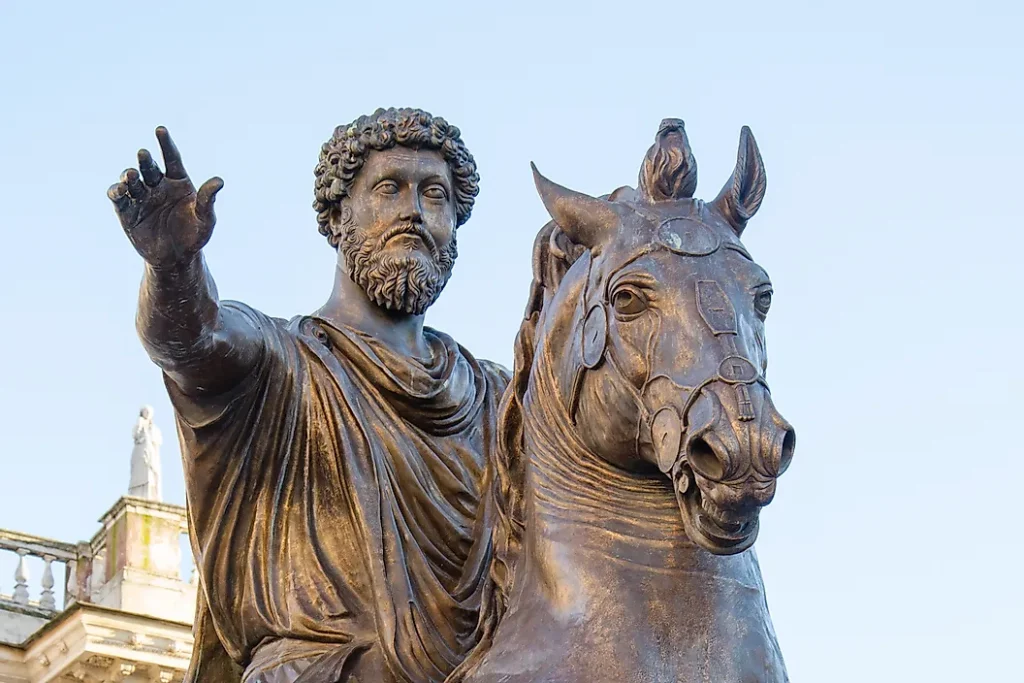
46. Rome is Home To The Greatest Surviving Equestrian Statue
Rome owns antiquity’s greatest surviving equestrian statue, the statue of Emperor Marcus Aurelius. Equestrian statues were popular in imperial Rome.
They celebrated an emperor’s civic and military accomplishments, and were often copied on coins. The horse is particularly compelling, caught in a moment of movement.
This sculpture originally may have graced the Roman Forum before being moved to the center of the Piazza del Campidoglio. Now, there’s now a 16th century copy in the square. The original is protected from the elements in a modern glass hall in the Capitoline Museums.
Marcus Aurelius was known more for his philosophical treatise, Meditations, than battlefield exploits. In the statue, he is making his famous gesture of clemency, pardoning the defeated Germanic tribes.
>>> Click there to book a ticket to the Capitoline Museums
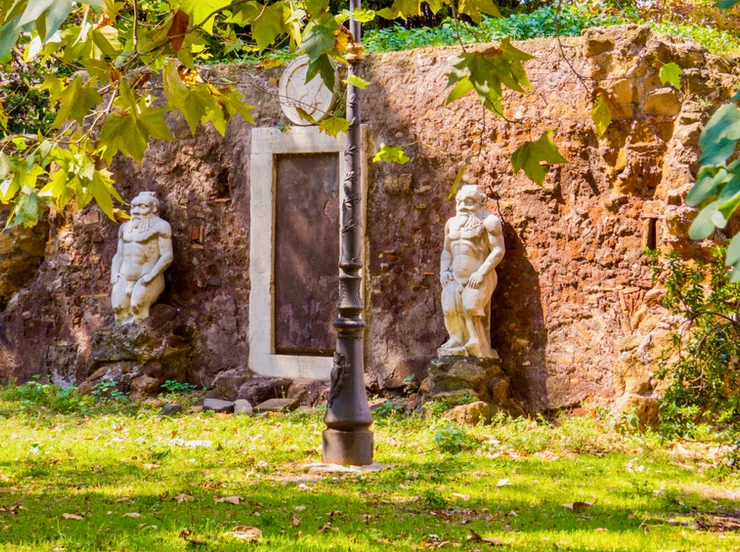
47. Rome Has A Magic Door
Rome’s Magic Door, or Poreta Alchemica, is well known to Romans. But it’s easy for tourists to miss.
Hidden in Piazza Vittorio, the Magic Door is a rather esoteric site. It’s a gateway into the secretive world of 17th century alchemy. It’s one of five remaining doors from the Villa Palombara.
Legend holds that Massimiliano Palombara met an alchemist who claimed he could turn metal into gold with a mysterious herb. Massimiliano hired him.
But the next day the alchemist vanished. He left only a few flakes of gold and a “recipe,” with symbols and equations, for the transformation.
Massimiliano posted an engraving of the recipe above the door, hoping someone would crack the code. But no one has deciphered its meaning.
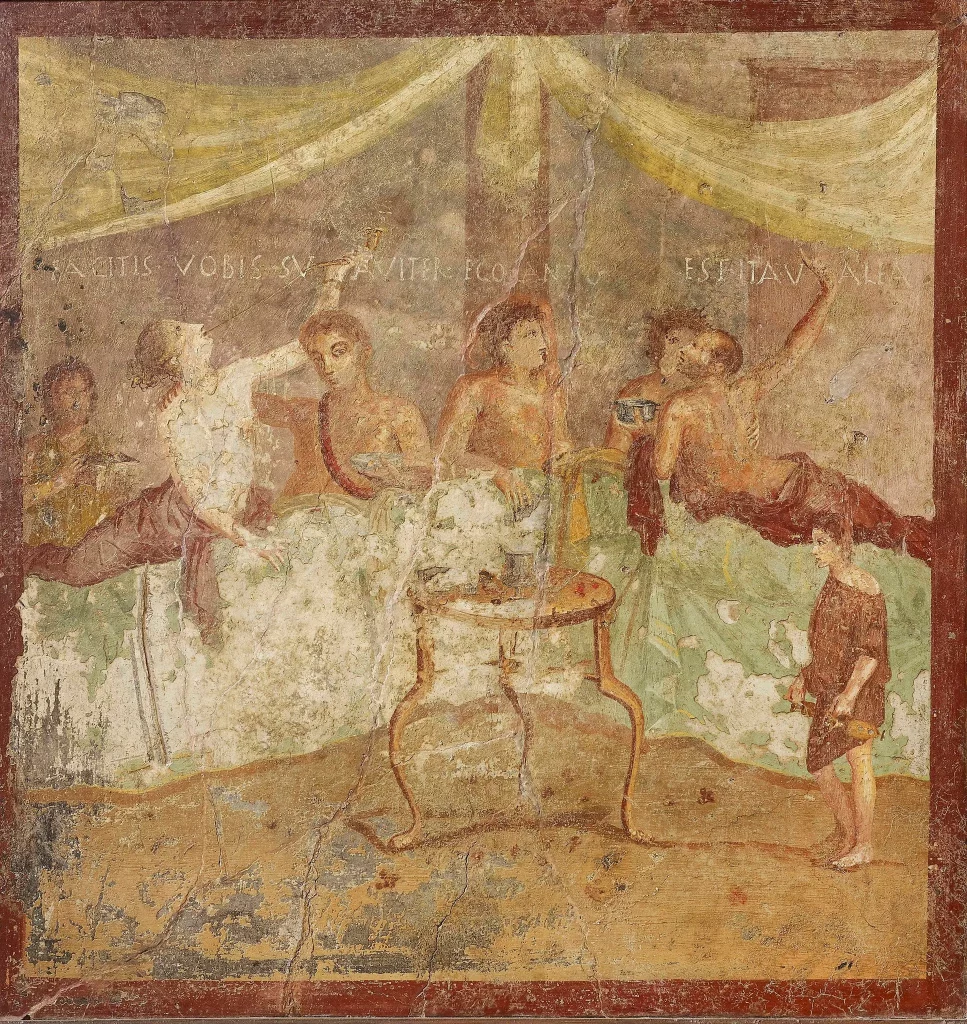
48. Vomitoriums Were Not For Throwing Up
Legend holds that the ancient Romans were so gluttonous that they would throw up lavish meals so that they could return for more.
It’s true that the Romans were famous for their love of food and drink. But they didn’t have special purging rooms.
Instead, a “vomitorium” was an entrance or alcove in a theater or colosseum. Citizens were spewed, or vomited, into or out of the building.
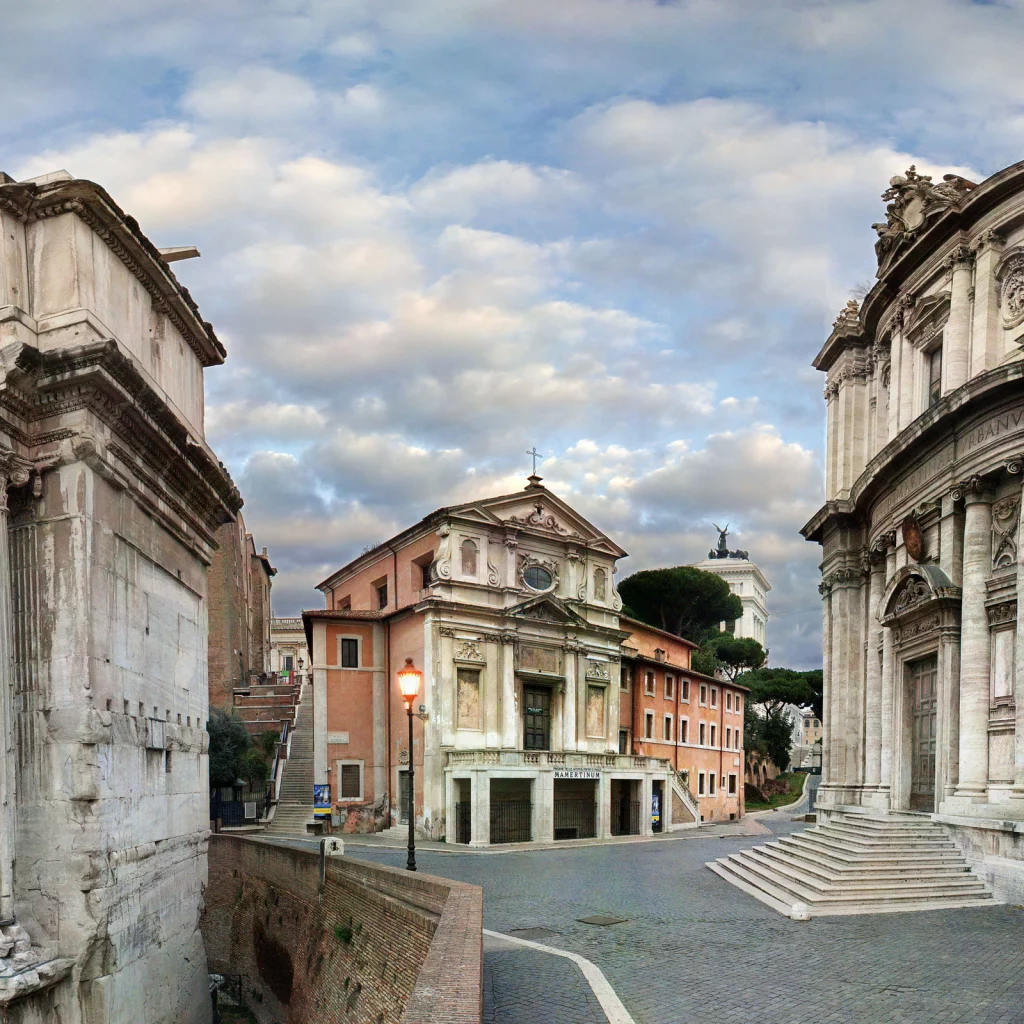
49. Rome Is Home To One Of The World’s Oldest Prison
Dating back to the 7th century B.C., Mamertine Prison is believed to be one of the oldest prisons in the world. It’s a significant historical site associated with the Roman Republic.
The prison, also known as the Tullianum, was originally constructed as a cistern. But it was later converted into a dungeon.
While prisons weren’t a common feature in classical Rome, this ancient lock up has survived down the ages. Legend holds that the Bible’s most hallowed saints, Peter and Paul, were imprisoned there before their executions.
The prison also held prominent figures like Jugurtha and Vercingetorix. After the fall of Rome, Mamertine Prison was a shrine for the cult-like worship of St. Peter.
>>> Click here to book a ticket to the prison
50. Rome Isn’t Fully Excavated
There’s even more revelations and interesting facts about Rome to come. Despite ongoing excavations, around 90% of Ancient Rome is buried underground and has yet to be unearthed. Rome is an archaeological layer cake.
Archaeologists estimate that ruins lie 30 feet below street level. It was common practice in Ancient Rome for architects to tear off the roofs of existing building, fill them with dirt, and create new foundations. This collapsed ancient structures.
Today, people and businesses reside in buildings built on top of the ruins. That means it’s unlikely the many ruins will be fully excavated.
I hope you’ve enjoyed my list of fascinating facts about Rome. If you’re headed to Rome, be sure to check out my top Rome posts:
- 3 day itinerary for Rome
- 5 day itinerary for Rome
- Hidden gems in Rome
- Best museums in Rome
- Archaeological sites in Rome
- Guide To Roman Ruins
- Rome’s secret palace museums
- Best day trips from Rome
- Guide to Palatine Hill
- Guide to the Roman Forum
- Guide to the Colosseum
If you need facts about Rome, pin it for later.

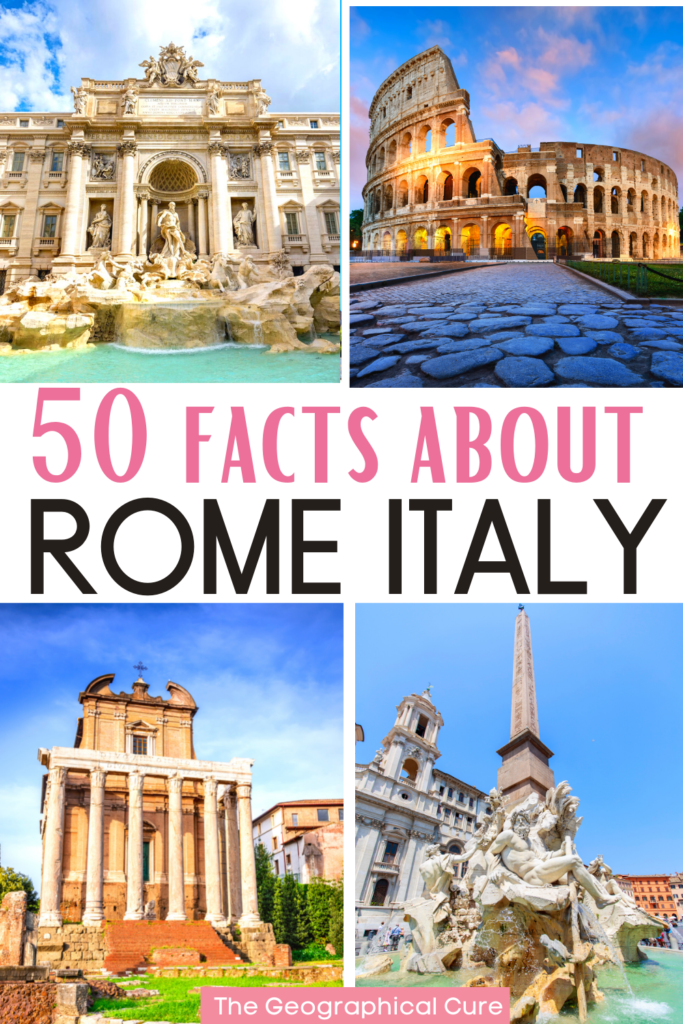
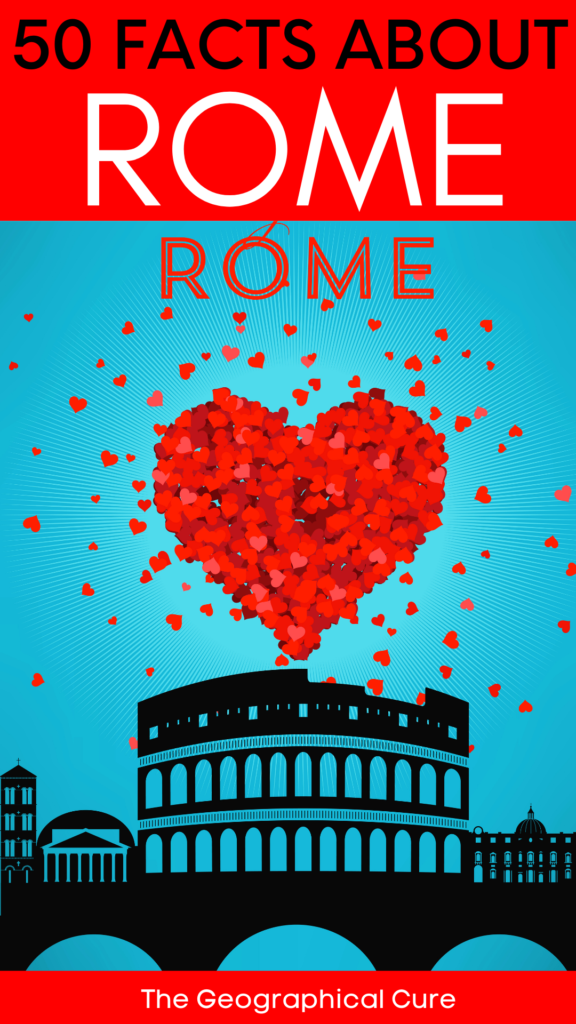
I have never been to Rome, but this article gives me enough reasons to visit this magnificent city!
Thanks! It’s a fabulous city, as long as you don’t go in the summer when it’s mobbed. Last time I visited, I was there for a week and never ran out of things to do.You should definitely plan a visit!